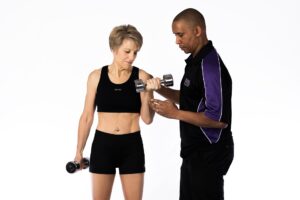Keeping your clients safe should be your number one priority. Unfortunately, injuries can occur for many reasons, including poor technique, over-reliance on specific exercises, and more. Today’s post will explore how to keep your clients training around an injury to maintain some fitness.
Reduce the Weight and Slow Down the Tempo
The first way to do bodybuilding with injuries is to reduce the weight you’re lifting and slow down the tempo of each repetition. Doing these two things is beneficial for providing the necessary growth stimulus without putting much stress on your joints, bones, and connective tissues. Blood flow restriction (BFR) training, also known as occlusion training, can be useful. The objective is to place a tourniquet as close to the heart as possible––for example, under the armpit for the arms, and at the top of the thighs, just below the buttocks. Doing so allows trainees to exhaust their muscles by lifting as light as 10 to 20 percent of their maximum.
Do More Machine Work
Machine exercises are a great way to do bodybuilding with injuries because the stability demands are much smaller. Trainees are also at a lower risk of doing movements with poor form. As a result, trainees can focus on activating the correct muscles.
Limit the Range of Motion
The next good way for clients to keep training with an injury is by limiting the range of motion to avoid irritation and further damage to the affected area. In most cases, shortening the range of motion makes movements less effective, but the tactic can be good for maintaining fitness while the injury heals. For example, let’s say that knee pain prevents you from doing the regular deadlift. You can shorten the range of motion by elevating the barbell inside a squat rack or on blocks and doing rack pulls. You’re essentially removing knee extension from the equation, reducing the pressure on the area.
Try Isometrics
Isometric exercises, also known as isometrics, are those where you assume a challenging position and maintain it for a specific period by keeping your muscles tense. While most people overlook isometrics, adding them to a training program can serve good prehab and rehab purposes. First, isometrics don’t depend on joint movement to be effective, which allows you to stimulate your muscles without irritating injuries. Second, isometrics are great for developing stability, which is necessary for maintaining proper form and reducing the risk of future injuries.
Good isometric activities include:
- Plank (regular, side, reverse, etc.)
- Wall sits
- L-sits
- Overhead hold
- Squat hold
Make Changes to Your Training
The final answer to the question “How to stay fit when injured?” is to change up variables within your training program. For example, you can change the angles of exercises. If the flat bench press irritates a joint or muscle, do the incline press. Similarly, change your grip width or stance to see if that allows you to train without aggravating an injury. Using a narrower grip for pulling exercises can be a great way to reduce shoulder irritation. You can also emphasize the non-injured site to prevent further damage or re-injury. For example, if you’ve injured your left elbow, only train your right side for a while.
Conclusion
Your number one priority should be to keep your clients safe and injury-free. Unfortunately, injuries can still occur for various reasons. The good news is that there are ways to safely train around an injury and maintain some of
your fitness while healing.







